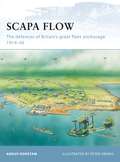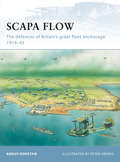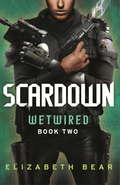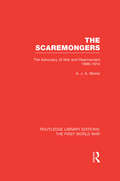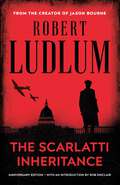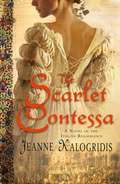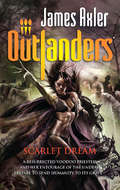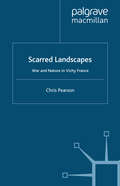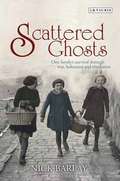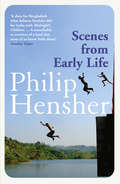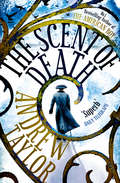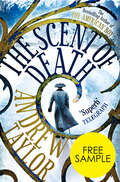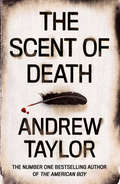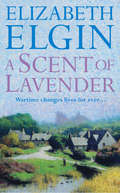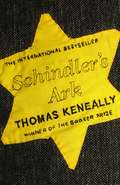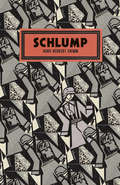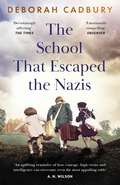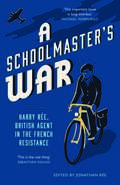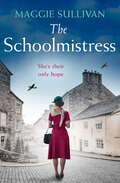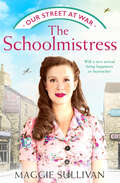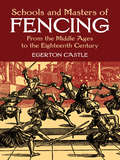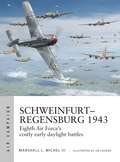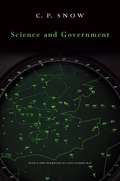- Table View
- List View
Scapa Flow: The defences of Britain’s great fleet anchorage 1914–45 (Fortress)
by Peter Dennis Angus KonstamA strategically important natural harbor in the Orkney Islands, Scapa Flow served as Britain's main fleet anchorage during World Wars I and II. In 1914 and again in 1939, the British began building a comprehensive defensive network by fortifying the entrances to Scapa Flow, and then extended these defenses to cover most of Orkney. By 1940, it had become an island fortress, the largest integrated defensive network of its kind in Europe, manned by as many as 50,000 Commonwealth troops. Backed by newly commissioned artwork, naval historian Angus Konstam tells the story of this mighty naval fortress, many pieces of which can still be seen on the island today.
Scapa Flow: The defences of Britain’s great fleet anchorage 1914–45 (Fortress #85)
by Peter Dennis Angus KonstamA strategically important natural harbor in the Orkney Islands, Scapa Flow served as Britain's main fleet anchorage during World Wars I and II. In 1914 and again in 1939, the British began building a comprehensive defensive network by fortifying the entrances to Scapa Flow, and then extended these defenses to cover most of Orkney. By 1940, it had become an island fortress, the largest integrated defensive network of its kind in Europe, manned by as many as 50,000 Commonwealth troops. Backed by newly commissioned artwork, naval historian Angus Konstam tells the story of this mighty naval fortress, many pieces of which can still be seen on the island today.
Scardown: Book Two (Jenny Casey #2)
by Elizabeth BearThe year is 2062, and after years on the run, Jenny Casey is back in the Canadian armed forces. Those who were once her enemies are now her allies, and at fifty, she's been handpicked for the most important mission of her life - a mission for which her artificially reconstructed body is perfectly suited. With the earth capable of sustaining life for just another century, Jenny - as pilot of the starship Montreal - must discover brave new worlds. And with time running out, she must succeed where others have failed.Now Jenny is caught in a desperate battle where old resentments become bitter betrayals and justice takes the cruelest forms of vengeance. With the help of a brilliant AI, an ex-crime lord, and the man she loves, Jenny may just get her chance to save the world. If it doesn't come to an end first . . .
The Scaremongers: The Advocacy of War and Rearmament 1896-1914 (Routledge Library Editions: The First World War)
by A. J. MorrisThis revealing book illustrates how the passion for war was fostered and promoted. The author provides detailed evidence of how and why an image of Germany as a nation determined upon world hegemony was deliberately promoted by a group of British newspaper editors, proprietors and journalists. This book examines the role of these ‘scaremongers’. Were they as influential as their critics claimed? Did they influence the minds of their readers and shape events? Were they guilty of creating a climate of opinion that ensured that their prophecies of inevitable Anglo-German war became fact in 1914?
The Scaremongers: The Advocacy of War and Rearmament 1896-1914 (Routledge Library Editions: The First World War)
by A. J. MorrisThis revealing book illustrates how the passion for war was fostered and promoted. The author provides detailed evidence of how and why an image of Germany as a nation determined upon world hegemony was deliberately promoted by a group of British newspaper editors, proprietors and journalists. This book examines the role of these ‘scaremongers’. Were they as influential as their critics claimed? Did they influence the minds of their readers and shape events? Were they guilty of creating a climate of opinion that ensured that their prophecies of inevitable Anglo-German war became fact in 1914?
The Scarlatti Inheritance: Action, adventure, espionage and suspense from the master storyteller (Mini-hardbacks Ser.)
by Robert LudlumIncludes a new introduction from bestselling author Rob SinclairThe Third Reich is in its death struggle...A spellbinding story of international terror and intrigue, greed and cunning, suspense and murder from the No. 1 bestselling master storyteller.'The real titan of the genre is Robert Ludlum' GQ'THE SCARLATTI INHERITANCE has drive and excitement from first page to last. Robert Ludlum is an ingenious storyteller' Mario PuzoIn Washington, word is received that an elite member of Nazi High Command is willing to defect and divulge information that will shorten the war. But his defection entails the release of the ultra top-secret file on the Scarlatti Inheritance - a file whose contents will destroy many of the Western world's greatest and most illustrious reputations if they are made known...
The Scarlet Contessa: A Novel Of The Italian Renaissance
by Jeanne KalogridisFrom Jeanne Kalogridis, critically acclaimed author of The Borgia Bride, Painting Mona Lisa and The Devil’s Queen, comes another irresistible historical novel about a countess whose passion and willfulness knew no bounds: Caterina Sforza.
Scarlet Dream
by James AxlerThe poisonous alien race masterminding centuries of calculated chaos and destruction for mankind underestimated the sheer tenacity of the human spirit. Now these technologically superior aggressors must contend with a dedicated group of warriors sworn to reclaim their planet. The odds against the Cerberus rebels are long, but the fight goes on.…
Scarred Landscapes: War and Nature in Vichy France
by C. PearsonBased on detailed archival research and site visits, Scarred Landscapes is the first environmental history of Vichy France. From mountains and marshlands to foresters and resisters, it examines the intricate and often surprising connections between war, history, and the 'natural' environment during these turbulent years.
Scattered Ghosts: One Family's Survival through War, Holocaust and Revolution
by Nick BarlayWhen two Hungarian Jewish refugees landed by accident in Britain in the winter of 1956, they had little idea what the future would hold. But they carried with them the traces of their turbulent past, just enough to provide the clues to their past. Scattered Ghosts combines memoir, investigation and travel to resurrect 200 years of wars and revolutions, from the Austro-Hungarian Empire via two totalitarianisms to contemporary Britain. It is the story of an all but disappeared world told through the eyes of a single family ruptured by great forces, and occasionally brought together by cherry strudel.Through haphazard and fragmented possessions - a blunt-pencilled letter; a final photograph; a hastily typed certificate; a protecting document; a farewell postcard from a distant place; a recipe - Nick Barlay retraces the footsteps of the vanished. There is the death march of a grandfather, the military manoeuvres of a great uncle, the final weeks and moments of a great grandmother deported to Auschwitz, two boys' survival of an untold massacre, and codenamed spies operating in Cold War Britain. The ordinary mysteries and emotional legacies still resonate today in the parallel lives of far-flung family members. Diaspora, division and cultural identity form the backdrop to the story of ancestors who walked barefoot from Eastern Europe to experience Communism and Nazism, and to outlive them both. Scattered Ghosts is a family history that explores the events, great and small, on which a family's existence hinges. How did one person survive and another die? How did a Soviet tank shell cause a revolution between sisters? How did two refugees escape an invading army? Where did successive generations end up? And, ultimately, where did the recipe for cherry strudel come from?
Scenes from Early Life: A Novel
by Philip HensherWinner of the Royal Society of Literature Ondaatje Prize, this is the new novel from the author of ‘King of the Badgers’ and the Man Booker-shortlisted ‘The Northern Clemency’.
The Scent of Death: The American Boy, The Scent Of Death
by Andrew Taylor*WINNER of the Ellis Peters Historical Dagger Award 2013*‘Andrew Taylor wrote superb historical fiction long before Hilary Mantel was popular’ Daily TelegraphFrom the No.1 bestselling author of THE AMERICAN BOY comes a new historical thriller set during the American War of Independence.
The Scent of Death: The American Boy, The Scent Of Death
by Andrew TaylorDiscover the Best Historical Crime Novel of 2013 (Crime Writers’ Association Ellis Peters Award) with this FREE 100 page extract from the No.1 bestselling author of THE AMERICAN BOY. ‘Andrew Taylor’s historical crime fiction is always an event,’ Guardian.
The Scent of Death: The American Boy, The Scent Of Death
by Andrew Taylor*WINNER of the Ellis Peters Historical Dagger Award 2013*‘Andrew Taylor wrote superb historical fiction long before Hilary Mantel was popular’ Daily TelegraphFrom the No.1 bestselling author of THE AMERICAN BOY comes a new historical thriller set during the American War of Independence.
A Scent of Lavender
by Elizabeth ElginA captivating tale of forbidden passion and wartime friendship from the bestselling author of THE WILLOW POOL and ONE SUMMER AT DEER’S LEAP.
Schindler's Ark: The Booker Prize winning novel filmed as ‘Schindler’s List’ (Textplus Ser.)
by Thomas KeneallyWinner of the Booker Prize and international bestseller, made into the award-winning film Schindler's List.* 27th January 2019: 25th anniversary of the movie, which will be re-released in the UK and Australia*In the shadow of Auschwitz, a flamboyant German industrialist grew into a living legend to the Jews of Cracow. He was a womaniser, a heavy drinker and a bon viveur, but to them he became a saviour. This is the extraordinary story of Oskar Schindler, who risked his life to protect Jews in Nazi-occupied Poland and who was transformed by the war into a man with a mission, a compassionate angel of mercy.
Schlump
by Hans Herbert GrimmA GERMAN CLASSIC FROM A FORGOTTEN AUTHORSchlump is seventeen, a romantic, a chancer and a dreamer. It's 1915 so naturally he volunteers for war. In France he is assigned an administrative position in a small town and has a marvellous time. But when he gets to the trenches, where death and mindless destruction are the everyday, he starts to understand something about war. Funny, brutal and charming, here’s the First World War from the perspective of the inimitable Schlump.
The School That Escaped the Nazis
by Deborah Cadbury'All the violence I had experienced before felt like a bad dream. It was a paradise. I think most of the children felt it was a paradise.'In 1933, as Hitler came to power, schoolteacher Anna Essinger hatched a daring and courageous plan: to smuggle her entire school out of Nazi Germany. Anna had read Mein Kampf and knew the terrible danger that Hitler's hate-fuelled ideologies posed to her pupils. She knew that to protect them she had to get her pupils to the safety of England. But the safe haven that Anna struggled to create in a rundown manor house in Kent would test her to the limit. As the news from Europe continued to darken, Anna rescued successive waves of fleeing children and, when war broke out, she and her pupils faced a second exodus. One by one countries fell to the Nazis and before long unspeakable rumours began to circulate. Red Cross messages stopped and parents in occupied Europe vanished. In time, Anna would take in orphans who had given up all hope; the survivors of unimaginable horrors. Anna's school offered these scarred children the love and security they needed to rebuild their lives, showing them that, despite everything, there was still a world worth fighting for.Featuring moving first-hand testimony, and drawn from letters, diaries and present-day interviews, The School That Escaped the Nazis is a dramatic human tale that offers a unique child's-eye perspective on Nazi persecution and the Holocaust. It is also the story of one woman's refusal to allow her beliefs in a better, more equitable world to be overtaken by the evil that surrounded her.
A Schoolmaster's War: Harry Ree - A British Agent in the French Resistance
by Jonathan ReeThe wartime adventures of the legendary SOE agent Harry Rée, told in his own words A school teacher at the start of the war, Harry Rée renounced his former pacifism with the fall of France in 1940. He was deployed into a secret branch of the British army and parachuted into central France in April 1943. Harry showed a particular talent for winning the confidence of local resisters, and guided them in a series of dramatic sabotage operations, before getting into a hand-to-hand fight with an armed German officer, from which he was lucky to escape. This might seem like a romantic story of heroism and derring-do, but Harry Rée's own war writings, superbly edited and contextualized by his son, the philosopher Jonathan Rée, are far more nuanced, shot through with doubts, regrets, and grief.
The Schoolmistress (Our Street at War #2)
by Maggie SullivanHeartwarming and nostalgic new Saga series from the author of Mother’s Day on Coronation Street.
The Schoolmistress (Our Street at War #2)
by Maggie SullivanHeartwarming and nostalgic new Saga series from the author of Mother’s Day on Coronation Street.
Schools and Masters of Fencing: From the Middle Ages to the Eighteenth Century (Dover Military History, Weapons, Armor Ser.)
by Egerton CastleThe standard reference on historical swordsmanship since its 1885 publication, this volume is still widely considered the definitive work on fencing history and the art of European swordsmanship. The author, Egerton Castle, traces fencing from its roots in the unschooled brawling of the Middle Ages to its latter-day precision and refinement, focusing particularly on the 16th-century development of the rapier and the weapon's popularity in Renaissance Italy, where Italian masters founded the modern art of swordsmanship.Envisioning the history of the sword as a history of humanity, the author proposes that the changes in modes of fencing corresponded to changes in manners. The rough, untutored fighting of the Middle Ages, for example, mirrored the supremacy of brute force in social and political life. The more subtle Renaissance era led to the ascendancy of the rapier and dagger, weapons of vicious elegance rather than sturdy brutality. Subsequent years saw a dwindling incidence of dueling, the decline of the sword to an article of gentlemen's apparel, and the reduction of swordsmanship to a courtly accomplishment akin to dancing."The subject is full of interest," the author notes in his Introduction, "not only for the fencer who looks upon his favourite pastime as a science, but also in a high degree for the novelist, the painter, the actor, and the antiquarian." All will welcome the return of this abundantly illustrated and long-out-of-print work.
Schweinfurt–Regensburg 1943: Eighth Air Force’s costly early daylight battles (Air Campaign)
by Marshall Michel IIIIn 1943, the USAAF and RAF launched the Combined Bomber Offensive, designed to systematically destroy the industries that the German war machine relied on. At the top of the hit list were aircraft factories and plants making ball-bearings – a component thought to be a critical vulnerability. Schweinfurt in southern Germany was home to much of the ball-bearing industry and, together with the Messerschmitt factory in Regensburg, which built Bf 109 fighters, it was targeted in a huge and innovative strike.Precision required that the targets were hit in daylight, but the raid was beyond the range of any existing escort fighter, so the B-17s would go in unprotected. The solution was to hit the two targets in a coordinated 'double-strike', with the Regensburg strike hitting first, drawing off the defending Luftwaffe fighters, and leaving the way clear for the Schweinfurt bombers. The Regensburg force would carry on over the Alps to North Africa, the first example of US 'shuttle bombing'.Although the attack on Regensburg was successful, the damage to Schweinfurt only temporarily stalled production, and the Eighth Air Force had suffered heavy losses. It would take a sustained campaign, not just a single raid, to cripple the Schweinfurt works. However, when a follow-up raid was finally launched two months later, the losses sustained were even greater. This title explains how the USAAF launched its daylight bombing campaign in 1943, the technology and tactics available for the Schweinfurt-Regensburg missions, and how these costly failures forced a change of tack.
Schweinfurt–Regensburg 1943: Eighth Air Force’s costly early daylight battles (Air Campaign #14)
by Marshall Michel IIIIn 1943, the USAAF and RAF launched the Combined Bomber Offensive, designed to systematically destroy the industries that the German war machine relied on. At the top of the hit list were aircraft factories and plants making ball-bearings – a component thought to be a critical vulnerability. Schweinfurt in southern Germany was home to much of the ball-bearing industry and, together with the Messerschmitt factory in Regensburg, which built Bf 109 fighters, it was targeted in a huge and innovative strike.Precision required that the targets were hit in daylight, but the raid was beyond the range of any existing escort fighter, so the B-17s would go in unprotected. The solution was to hit the two targets in a coordinated 'double-strike', with the Regensburg strike hitting first, drawing off the defending Luftwaffe fighters, and leaving the way clear for the Schweinfurt bombers. The Regensburg force would carry on over the Alps to North Africa, the first example of US 'shuttle bombing'.Although the attack on Regensburg was successful, the damage to Schweinfurt only temporarily stalled production, and the Eighth Air Force had suffered heavy losses. It would take a sustained campaign, not just a single raid, to cripple the Schweinfurt works. However, when a follow-up raid was finally launched two months later, the losses sustained were even greater. This title explains how the USAAF launched its daylight bombing campaign in 1943, the technology and tactics available for the Schweinfurt-Regensburg missions, and how these costly failures forced a change of tack.
Science and Government (The\godkin Lectures On The Essentials Of Free Government And The Duties Of The Citizen Ser. #9)
by C. P. SnowScience and Government is a gripping account of one of the great scientific rivalries of the twentieth century. The antagonists are Sir Henry Tizard, a chemist from Imperial College, and Frederick Lindemann (Lord Cherwell), a physicist from the University of Oxford. The scientist-turned-novelist Charles Percy Snow tells a story of hatred and ambition at the top of British science, exposing how vital decisions were made in secret and sometimes with little regard to truth or the prevailing scientific consensus. Tizard, an adviser to a Labor government, believed the air war against Nazi Germany would be won by investing in the new science of radar. Lindemann favored bombing the homes of German citizens. Each man produced data to support his case, but in the end what mattered was politics. When Labor was in power, Tizard’s view prevailed. When the Conservatives returned, Lindemann, who was Winston Churchill’s personal adviser, became untouchable. Snow’s 1959 “Two Cultures” Rede Lecture propelled him to worldwide fame. Science and Government, originally the 1960 Godkin Lectures at Harvard, has been largely forgotten. Today the space occupied by scientists and politicians is much more contested than it was in Snow’s time, but there remains no better guide to it than Snow’s dramatic narrative.
